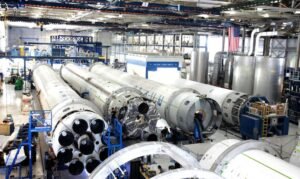How Tesla Makes Money
Tesla, Inc. is an American electric vehicle and clean energy company founded by Elon Musk, JB Straubel, Martin Eberhard, Marc Tarpenning, and Ian Wright. Since its inception in 2003, Tesla has been revolutionizing the automotive industry with its innovative electric vehicles and renewable energy solutions.
Key Takeaways:
- Tesla generates revenue primarily through the sale of electric vehicles.
- The company also makes money through energy generation and storage products.
- Tesla’s revenue is supplemented by other services, such as software updates and maintenance.
Tesla’s main source of revenue is the sale of electric vehicles. The company manufactures and sells a range of electric cars, including the popular Model S, Model 3, Model X, and Model Y. These vehicles are powered by lithium-ion batteries, which are recharged using Tesla’s extensive Supercharger network, providing *fast and convenient charging options* for Tesla owners.
In addition to electric vehicles, Tesla also generates revenue through its energy generation and storage products. The company produces solar panels and solar roof tiles, allowing customers to generate and utilize clean energy. Tesla’s Powerwall, a home battery storage system, enables users to store excess energy for later use or to power their homes during peak demand periods.
Tesla’s Revenue Streams
Tesla’s revenue streams can be categorized into the following:
- Automotive Sales: Revenue from the sale of electric vehicles.
- Energy Generation and Storage: Revenue from solar panels, solar roof tiles, and energy storage products.
- Services: Revenue from software updates, maintenance, and other services.
Tesla’s automotive sales account for the majority of its revenue. The company offers various vehicle models at different price points, appealing to a wide range of consumers. *The demand for electric vehicles continues to grow as more people recognize the environmental benefits and technological advancements* offered by Tesla’s products.
| Year | Automotive Revenue ($ billions) |
|---|---|
| 2018 | 13.73 |
| 2019 | 16.21 |
| 2020 | 27.23 |
*In 2020, Tesla’s automotive revenue more than doubled compared to 2019*, reflecting the increasing demand for electric vehicles and the company’s expansion into new markets.
Tesla’s energy generation and storage segment is also a significant contributor to its revenue. Customers who opt for Tesla’s solar panels, solar roof tiles, or Powerwall contribute to this stream of income. *The growing adoption of renewable energy solutions presents a lucrative market for Tesla’s products in the long term*.
| Year | Energy Generation and Storage Revenue ($ millions) |
|---|---|
| 2018 | 1,682 |
| 2019 | 1,530 |
| 2020 | 1,986 |
*Tesla’s energy generation and storage revenue remained relatively stable between 2018 and 2019*, indicating consistent demand for sustainable energy solutions. However, the revenue increased in 2020, potentially due to the company’s continued innovation in this sector.
Lastly, Tesla’s revenue is supplemented by its services, including software updates and maintenance. These services provide additional income streams for the company and contribute to the overall customer experience. Tesla’s commitment to continually improving its products through software updates has resonated with customers, further driving their loyalty.
Conclusion
Tesla’s revenue primarily comes from the sale of electric vehicles, with additional streams generated from energy generation and storage products, as well as services. The company’s innovative approach to sustainable transportation and renewable energy solutions has positioned Tesla as a leader in the industry. As the world shifts towards a more sustainable future, Tesla’s revenue streams are expected to continue growing.

Common Misconceptions
Tesla Makes Money By Selling Electric Cars Only
One common misconception about Tesla is that it makes money solely by selling electric cars. While it is true that the majority of Tesla’s revenue comes from car sales, the company has diverse sources of income:
- Tesla also makes money by selling energy storage products, such as its Powerwall and Powerpack systems.
- Another significant source of income for Tesla is its sale of regulatory credits to other automakers, which helps them meet emissions standards.
- Tesla has a growing services and maintenance business that contributes to its revenue stream.
Tesla Relies on Government Subsidies
Another misconception is that Tesla’s success is heavily dependent on government subsidies. While it is true that government subsidies have played a role in supporting Tesla’s growth, it is incorrect to assume that without subsidies, Tesla would not be profitable:
- Tesla’s success is primarily driven by its strong commitment to innovation, technological advancements, and market demand for electric vehicles.
- The company’s ability to deliver high-quality products and its strong brand reputation contribute significantly to its profitability.
- Tesla’s competitive advantage lies in its vertically integrated business model, which allows it to control various aspects of the production process, from battery cell manufacturing to vehicle assembly.
Tesla’s Financial Success Is Based on Speculative Investments
Some people falsely believe that Tesla’s financial success is solely based on speculative investments. While Tesla does generate revenue from investments, such as selling its stock or issuing convertible bonds, its profitability is not just reliant on these investments:
- Tesla has consistently reported positive net income in recent quarters, indicating that its core operations are financially robust.
- The company’s strong sales growth, expanding global market reach, and cost management strategies have contributed to its financial success.
- Investments play a supporting role in Tesla’s growth and expansion plans, but they are not the basis of its profitability.
Tesla’s Electric Vehicles Are Not Practical for Everyday Use
There is a misconception that Tesla’s electric vehicles are not practical for everyday use, mainly due to concerns about range anxiety and charging infrastructure limitations. However, this misconception is not accurate:
- Tesla’s extensive Supercharger network provides fast-charging options, enabling long-distance travel without significant delays.
- The company’s vehicles have impressive driving ranges that make them suitable for most daily commutes and typical driving habits.
- Technological advancements in battery technology have significantly improved range and charging speeds, further enhancing the practicality of Tesla’s electric vehicles.
Tesla’s Success Is Purely Based on Elon Musk’s Celebrity Status
While Elon Musk‘s high-profile persona has undoubtedly brought attention to Tesla, it is incorrect to assume that the company’s success is solely dependent on his celebrity status. Tesla’s achievements are the result of various factors:
- Tesla has a dedicated team of engineers, designers, and employees who work collaboratively to innovate and deliver high-quality products.
- The company’s focus on sustainable energy, environmental consciousness, and technological advancements resonates with a growing consumer segment interested in electric vehicles.
- Tesla’s product performance, safety features, and customer satisfaction contribute to its success, regardless of Elon Musk’s personal brand recognition.

Introduction
Tesla, the innovative electric vehicle company, has revolutionized the automotive industry and made a significant impact on the global market. This article delves into how Tesla makes money, showcasing various aspects of their business model. Please find below ten compelling tables that provide a deeper insight into their revenue sources, production figures, and market position.
Tesla Vehicle Deliveries (2016-2020)
The table below displays the annual number of vehicle deliveries by Tesla from 2016 to 2020. It illustrates the remarkable growth in their sales, demonstrating the increasing demand for their electric vehicles.
| Year | Number of Vehicle Deliveries |
|---|---|
| 2016 | 76,230 |
| 2017 | 103,020 |
| 2018 | 245,240 |
| 2019 | 367,500 |
| 2020 | 499,550 |
Energy Generation and Storage Revenue (2020)
This table provides an overview of Tesla’s revenue generated through energy generation and storage solutions for the year 2020. It highlights the growing contribution of this sector to their overall business.
| Energy Generation and Storage Segment | Revenue (in millions USD) |
|---|---|
| Solar Energy Products | 1,995 |
| Energy Storage Products | 1,197 |
Revenue Breakdown (2020)
The table below presents a breakdown of Tesla’s revenue by segment for the year 2020. It demonstrates the significant proportion derived from automotive sales, as well as the increasing role of other revenue streams.
| Segment | Revenue (in millions USD) |
|---|---|
| Automotive Sales | 26,006 |
| Services and Other | 1,993 |
| Energy Generation and Storage | 3,192 |
| Total | 31,191 |
Net Income Trend (2016-2020)
This table showcases Tesla’s net income trend over a five-year period, reflecting their financial performance and growth trajectory.
| Year | Net Income (in millions USD) |
|---|---|
| 2016 | -674 |
| 2017 | -1,961 |
| 2018 | 139 |
| 2019 | 143 |
| 2020 | 721 |
Global Electric Vehicle Market Share (2020)
This table illustrates Tesla’s market share within the global electric vehicle market in the year 2020. It highlights the company’s dominance in this sector.
| Automaker | Market Share |
|---|---|
| Tesla | 16% |
| Others | 84% |
R&D Investment (2019-2020)
The table below showcases Tesla’s research and development (R&D) expenses for consecutive years. It reveals their ongoing commitment to innovation and technological advancement.
| Year | R&D Investment (in millions USD) |
|---|---|
| 2019 | 1,340 |
| 2020 | 1,548 |
Tesla Supercharger Stations (2020)
This table provides insights into the number of global Tesla Supercharger stations and the corresponding charging stalls as of 2020. It depicts the extensive charging infrastructure they have established.
| Region | Number of Supercharger Stations | Number of Charging Stalls |
|---|---|---|
| North America | 807 | 6,434 |
| Europe | 570 | 5,413 |
| Asia-Pacific | 481 | 5,746 |
Number of Tesla Employees (2020)
This table highlights the total number of employees working for Tesla in the year 2020, providing an indication of their workforce scale.
| Region | Number of Employees |
|---|---|
| United States | 48,016 |
| International | 58,489 |
| Total | 106,505 |
Battery Cell Production Capacity (2020)
This table portrays Tesla’s battery cell production capacity as of 2020. It signifies their focus on building an efficient and sustainable energy storage infrastructure.
| Factory | Location | Production Capacity (GWh) |
|---|---|---|
| Gigafactory Nevada | USA | 35 |
| Gigafactory Shanghai | China | 20 |
| Total | 55 |
Conclusion
Through these tables, we gain valuable insights into how Tesla generates revenue, evidencing their success in the automotive and energy sectors. Tesla’s increasing vehicle deliveries, thriving energy generation and storage segments, and impressive market share illustrate their strong market position. Furthermore, the company’s continued investment in R&D, charging infrastructure, and battery cell production enhances their competitiveness and commitment to sustainable solutions. Tesla’s financial performance, characterized by growing net income, showcases their revenue-generating potential. Overall, Tesla’s innovative approach and commitment to revolutionizing transportation and clean energy have established them as a key player in the industry.
Frequently Asked Questions
How does Tesla earn revenue?
How does Tesla generate income?
What are Tesla’s other sources of income?
Can you explain Tesla’s other revenue streams?
How does Tesla make a profit?
Does Tesla generate profits?
What is Tesla’s business model?
Can you explain Tesla’s business model?
How does Tesla’s pricing strategy work?
What can you tell me about Tesla’s pricing strategy?
What impact does government incentives have on Tesla’s revenue?
How do government incentives affect Tesla’s earnings?
What is Tesla’s approach to marketing?
How does Tesla approach marketing its products?
Does Tesla rely on partnerships for its success?
How important are partnerships to Tesla’s success?
How does Tesla manage its supply chain?
Can you explain how Tesla handles its supply chain?
What are Tesla’s future growth prospects?
Can you provide insights into Tesla’s growth potential?




